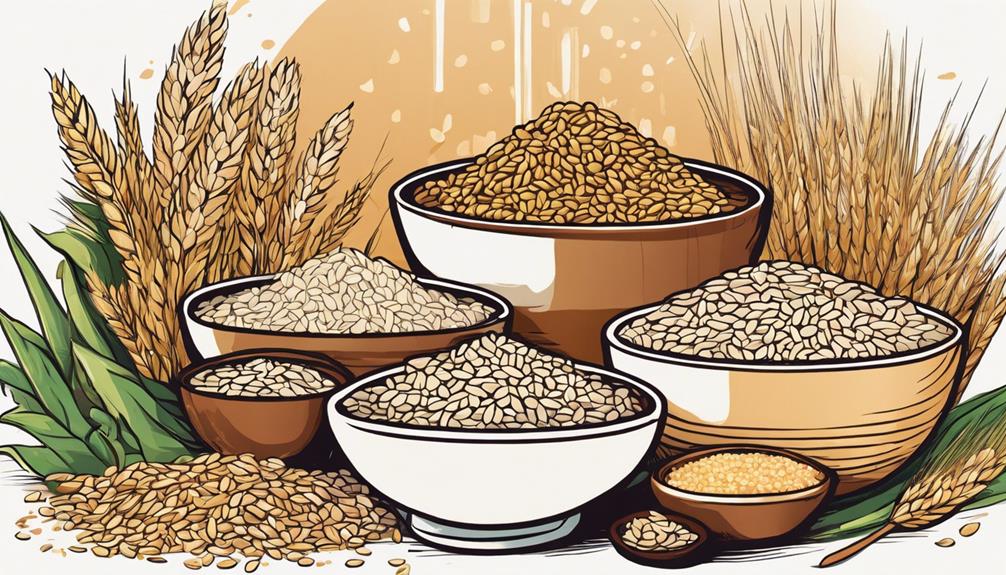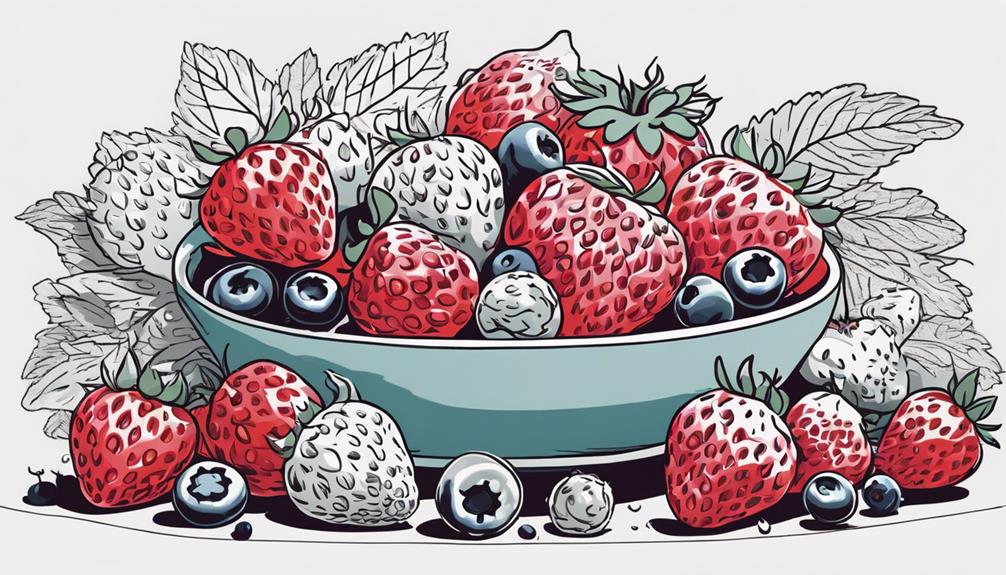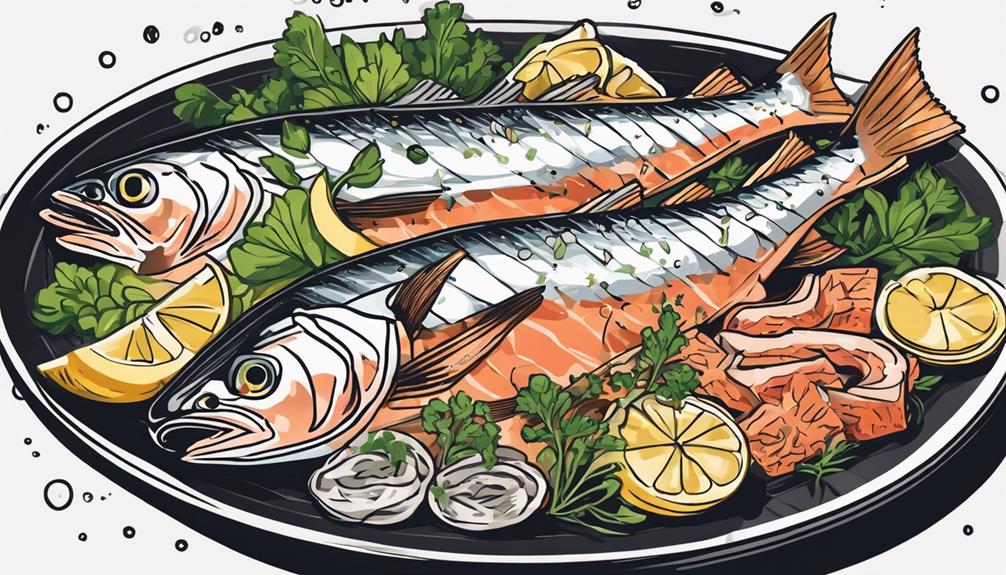You may think that a diabetes-preventing diet consists of bland, uninspiring foods, but you'd be surprised to learn that some of the tastiest options can actually help you stay healthy.
Imagine enjoying delicious meals while also taking care of your well-being. These top foods not only satisfy your taste buds but also work wonders in keeping your blood sugar levels stable.
Stay tuned to discover how simple dietary choices can have a significant impact on your overall health and potentially prevent the onset of diabetes.
Key Takeaways
- Choose whole grains like quinoa and brown rice for stable blood sugar levels.
- Incorporate leafy greens such as spinach and kale for essential nutrients and blood sugar regulation.
- Enjoy berries like strawberries and blueberries to help manage blood sugar with their low glycemic index.
- Include nuts, seeds, and fatty fish rich in omega-3s for overall health and diabetes prevention.
Whole Grains

Incorporate whole grains into your daily meals to enhance your diabetes-preventing diet. Whole grains are rich in fiber, which offers numerous benefits for your health. Fiber helps regulate blood sugar levels by slowing down digestion and the absorption of carbohydrates, thus preventing spikes in blood glucose. This is vital for diabetes prevention as stable blood sugar levels reduce the risk of developing insulin resistance.
When choosing whole grains, consider the glycemic index of the food. Foods with a lower glycemic index release glucose more slowly into the bloodstream, preventing sudden spikes in blood sugar levels. Whole grains like quinoa, brown rice, and oats have a lower glycemic index compared to refined grains, making them excellent choices for managing blood sugar levels effectively.
Leafy Greens
To further enhance your diabetes-preventing diet, prioritize incorporating leafy greens into your meals as they offer essential nutrients and health benefits. Leafy greens are versatile and can be enjoyed in various ways, from refreshing salads to nutrient-packed smoothies.
Here are five reasons why leafy greens should be a staple in your diet:
- Rich in Fiber: Leafy greens like spinach and kale are packed with fiber, promoting digestive health and aiding in blood sugar control.
- Low in Calories: These greens are low in calories but high in essential vitamins and minerals, making them a perfect choice for weight management.
- Antioxidant Powerhouses: Leafy greens are rich in antioxidants that help protect your cells from damage and reduce inflammation.
- Blood Sugar Regulation: The nutrients in leafy greens can help regulate blood sugar levels, making them a great choice for individuals at risk of diabetes.
- Versatile and Delicious: From nutrient-packed salads to refreshing smoothie greens, leafy greens can be incorporated into your diet in countless delicious ways.
Make leafy greens a regular part of your meals to reap their numerous health benefits and support your diabetes prevention efforts.
Berries

Berries are nutrient-dense fruits that offer a multitude of health benefits, making them a valuable addition to a diabetes-preventing diet. These vibrant fruits are packed with antioxidants, such as flavonoids and anthocyanins, which play a crucial role in reducing oxidative stress and inflammation in the body.
One key benefit of including berries in your diet is their ability to aid in blood sugar regulation. The high fiber content in berries, along with their low glycemic index, can help prevent spikes in blood sugar levels after meals, making them an excellent choice for individuals looking to manage or prevent diabetes.
Whether you prefer strawberries, blueberries, raspberries, or blackberries, incorporating a variety of berries into your daily meals can provide a delicious way to support your overall health and well-being. Try adding them to your morning yogurt, blending them into a smoothie, or enjoying them as a sweet snack on their own.
Nuts and Seeds
Nuts and seeds are excellent additions to your diet for preventing diabetes, offering a wealth of nutritional benefits that support overall health and well-being.
- Rich in Healthy Fats: Nuts and seeds are packed with healthy fats like omega-3 fatty acids, which are beneficial for heart health.
- Fiber Powerhouses: These crunchy snacks are high in fiber, promoting better blood sugar control and aiding in digestion.
- Nutrient-Dense: Nuts and seeds contain essential vitamins, minerals, and antioxidants that bolster your immune system.
- Satisfying Snack Options: Incorporating nuts and seeds into your meals can help you feel full longer, reducing the temptation for unhealthy snacks.
- Portion Control is Key: While nutrient-dense, nuts and seeds are calorie-dense too, so moderation is crucial for maintaining a healthy weight.
Including a variety of nuts and seeds in your diet while practicing portion control can be a delicious and effective way to help prevent diabetes and enhance your overall well-being.
Fatty Fish

When looking to further enhance your diabetes-preventing diet, consider incorporating fatty fish as a key component due to its numerous health benefits. Fatty fish, such as salmon, mackerel, and sardines, are rich in omega-3 fatty acids, which have been shown to reduce inflammation, improve blood vessel function, and lower the risk of heart disease – all important factors in managing diabetes.
Omega-3 benefits extend beyond heart health; these fatty acids may also improve insulin sensitivity and reduce the risk of developing type 2 diabetes. To maximize these benefits, aim to include fatty fish in your diet at least twice a week. When preparing fatty fish, opt for healthy cooking methods such as grilling, baking, or broiling to retain their nutritional value.
When selecting fatty fish, prioritize sustainable sourcing to support healthy fish populations and reduce environmental impact. Additionally, be mindful of mercury levels, especially in larger fish like tuna, and vary your choices to minimize exposure. By incorporating fatty fish into your meals mindfully, you can enjoy a delicious and diabetes-friendly way to boost your health.
Frequently Asked Questions
Are There Any Specific Portion Sizes Recommended for Incorporating Whole Grains Into a Diabetes-Preventing Diet?
To incorporate whole grains in a diabetes-preventing diet, aim for ½ cup cooked grains per meal. Opt for brown rice, quinoa, or whole wheat pasta. Portion control is key. Enjoy whole grains with leafy greens to boost fiber intake and overall nutrition.
Can Leafy Greens Be Cooked in a Way That Maximizes Their Nutritional Benefits for Diabetes Prevention?
When it comes to leafy greens, consider steaming them for maximum nutrition absorption, enhancing their benefits for diabetes prevention. Sautéed or raw, these greens pack a punch of essential nutrients to support your health goals.
Are There Certain Types of Berries That Are More Beneficial for Managing Blood Sugar Levels Than Others?
When managing blood sugar levels, opt for berries like blueberries, strawberries, and raspberries. These are among the best berries for blood sugar management. They contain fiber, antioxidants, and have a lower glycemic index compared to other fruits.
Is There a Recommended Daily Intake of Nuts and Seeds for Individuals Looking to Prevent Diabetes?
If you're aiming to prevent diabetes, it's recommended to include a variety of nuts and seeds in your daily intake. These nutritional supplements offer a range of health benefits, so enjoy them in moderation.
What Are Some Creative Ways to Incorporate Fatty Fish Into a Diabetes-Preventing Diet for Those Who May Not Enjoy Eating Fish Regularly?
To enjoy fatty fish in a diabetes-preventing diet without eating it directly, try fish alternatives like algae-based supplements. Flavorful cooking methods like grilling or baking with herbs can make it more appealing. Vegetarian options or sneaky substitutions can also be tasty.
Conclusion
So remember, incorporating whole grains, leafy greens, berries, nuts and seeds, and fatty fish into your diet can help prevent diabetes.
Think of your body as a garden – by feeding it these nutrient-rich foods, you're planting seeds of health and vitality.
Just like a garden needs care and attention to flourish, your body thrives when nourished with the right foods.
Make the choice to prioritize your health and reap the benefits for years to come.